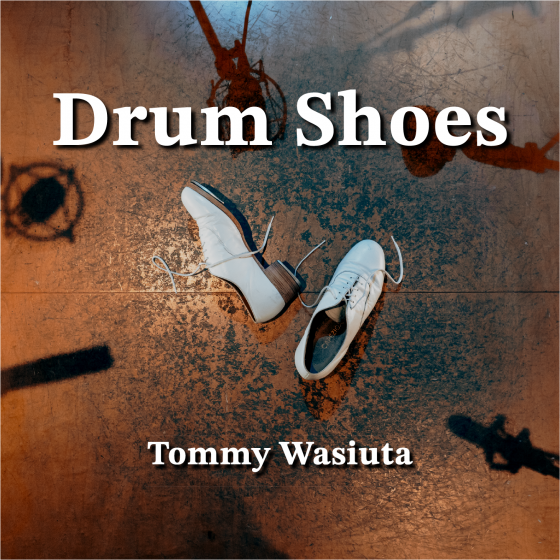
Tommy Wasiuta, who studied accounting at UMSL, has worked as professional tap dancer in New York City for the past few years, performing at venues including Chelsea Factory (pictured here). This fall, he released his debut solo album. (Photo by Christopher Duggan)
Ever since he took his first tap dance class at 3 years old, Tommy Wasiuta grew up as a “competition kid,” training at dance studios, learning different dance routines and performing at various competitions. When he was a senior in high school, he traveled to his first tap intensive outside of Missouri, Sarah Reich’s Tap Music Project in New York City. There, he learned about rhythm notation, or how to listen to tap dance and write it down in sheet music form. The experience reinforced an idea that has run central through his career: Tap dancers are musicians.
Wasiuta, who graduated from the University of Missouri–St. Louis in 2020, has worked as a professional tap dance artist in New York City since 2021. After transferring to UMSL from St. Charles Community College through the A+ Scholarship Program for his junior and senior years, he decided to study accounting, but never lost sight of his love of tap dance. He took an elective course on different drumming cultures around the world with UMSL Director of Percussion Studies Matthew Henry and was able to perform on stage with the jazz ensemble during his junior year.
“I went to UMSL, and I was studying accounting, but college is not just limited to what you’re studying,” Wasiuta said. “You can go into different areas. I was performing with the jazz ensemble as an accounting major, which I think is cool. It’s just a good reminder for students that you can reach over and put your hands in many different places at UMSL. For me, it felt like a place that supported that sort of cross-profession collaboration.”
Along with some friends, he also founded the St. Louis Rhythm Collaborative, which gave him an avenue to continue performing and doing tap outreach in the community. After graduating from UMSL, Wasiuta landed an accounting job at a company that specialized in personal tax returns for artists and decided to move to New York City. He gained a tremendous amount of knowledge about managing financials and filing taxes for people who are self-employed and was also able to connect with lots of artists working across different mediums. Eventually, he knew he needed to dive headfirst into his passion.
“I felt like I had a voice in tap dance and in music,” he said. “So I wanted to pursue that full force. I wanted to fully speak out so that I never had the regret of not at least trying it full force for a little while.”
Wasiuta has performed in iconic New York City venues such as the Joyce Theatre and the 92nd Street Y and teaches tap at studios including Steps on Broadway and the King Centre for the Performing Arts. He also loves performing with jazz musicians during more spontaneous jam sessions in local jazz clubs.
“What’s cool about tap dance is it is very much side-by-side with jazz music,” Wasiuta said. “The two art forms grew up together. As jazz music was gaining popularity and evolving, tap dancers were influencing the jazz musicians and the jazz musicians were influencing the tap dancers, so they both helped each other progress as art forms. Jazz jam sessions are a lot of fun. It’s always something new, always something different, which is exciting.”

Wasiuta hopes to start performing in more local venues, particularly on the heels of his debut solo album, “Drum Shoes,” which was released on streaming services at the end of September. According to Wasiuta, the audio album is the first of its kind – it focuses entirely on the rhythmic and musical capabilities of tap shoes, which Wasiuta views as similar to that of a drum set. He was particularly inspired by solo drum albums by artists including Jo Jones, Nate Smith and Ulysses Owens Jr., the latter of whom he has worked with on a few projects.
“He’s one of the best jazz drummers right now, so to work closely with a drummer of his caliber has absolutely shaped my perspective on the drums and on music,” Wasiuta said. “It’s definitely influenced my tap dancing to think more like a drummer. I would encourage tap dancers to seek additional education about the musicality of the steps they learn in class.
Wasiuta designed the album to be an interactive experience for listeners. “Trade with Me!”, for instance, is a song inspired by the tap dance tradition of trading, in which dancers will trade bars of music back and forth. Listeners – whether fellow tap dancers, musicians or otherwise – can use the recording as inspiration and practice alongside it. In addition to the album, he also created a coinciding book, “Drum Shoes: The Transcription Book” with transcriptions of seven of the songs. The book includes sheet music and notes about Wasiuta’s inspirations behind the original compositions and is designed to help readers follow along as they listen.
“Tap dancers are dancers, yes, but we’re also playing music as we’re dancing, which is a really unique thing,” Wasiuta said. “The book allows the reader to go through and learn more about the song and then see what the music looks like and the rhythms that I’m playing, and they can get a full breakdown of what’s being played on the album.”
Wasiuta said he’s already received a lot of support for the album from the close-knit tap community. For those who might not be as familiar with tap, he hopes the album can reinforce that notion of tap dance as music that’s stuck with him since high school.
“There’s usually a stigma that’s connected to tap dance – it’s all about the arms, or it’s all about just shuffling the feet randomly,” he said. “You’re not really making any specific sort of choices musically, but just flailing the feet and sound is made. I’m hoping that this book and album kind of breaks that stigma because people get to listen to the song and also realize, ‘Oh, this is being inspired by a musical instrument.’ A great tap dancer can have no audio – a video of a tap dancer would still be entertaining to watch based on the movement – and then on the flip side, if you took away the video and only had the audio, it would still be music to listen to as well. I wanted to be a reminder that there’s a whole other complex world on the music side of it. It’s been receiving a lot of support and making people think about tap dance in a different way.”














